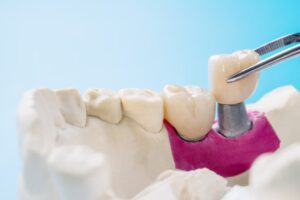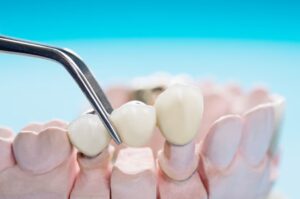How different materials affect your dental restoration
At Aurora Smiles, under the skilled guidance of Dr. Amul G. Patel, patients receive dental restorations that are carefully chosen based on both functional and aesthetic considerations. The choice of material plays a central role in how a dental restoration performs, feels, and looks over time. Not all materials are created equal, and their differences can influence everything from the way your bite feels to the durability of the restoration itself. Whether it is a crown, bridge, dental implant, or filling, the materials used have unique properties that interact differently with your teeth, gums, and lifestyle. With ever-changing advancements in dental technology, patients now have access to a broader range of materials than ever before. This provides more opportunities for long-lasting and visually appealing solutions. The discussion about restorative materials typically begins with an understanding of the function you want your restoration to fulfill. Should it endure heavy chewing pressure? Should it match your natural tooth color perfectly? Or do you need something biocompatible for long-term comfort? All of these factors come into play. At Aurora Smiles, patients benefit from Dr. Amul G. Patel’s experience and deep understanding of these materials to help them make the most suitable decisions. If you are exploring your options through restorative dentistry in Mt. Vernon, NY, understanding the impact of material choice is a vital first step.

The Foundation of Restorative Dentistry: A Material-Driven Approach
The science of dental restoration is deeply tied to the materials used. Historically, dental restorations were made from metals like gold or amalgam due to their strength and ease of use. While these materials were highly functional, they often fell short in terms of aesthetics and long-term compatibility with gum tissue. Today, patients have access to more sophisticated materials such as zirconia, porcelain, composite resin, and even hybrid ceramics. Each of these brings its own unique benefits and considerations. The shift in materials reflects a broader change in dentistry—one that recognizes the importance of creating restorations that not only last but also feel natural and look beautiful.
The process of choosing a material starts with evaluating the patient’s dental needs and goals. For example, someone who grinds their teeth at night may require a more durable material like zirconia, whereas a front-tooth restoration might benefit from porcelain for its translucency and ability to mimic the look of enamel. Even the location of the restoration plays a role in material selection, with molars often needing stronger options and incisors benefiting more from aesthetics.
Metal Restorations: The Original Workhorse of Dentistry
Though used less frequently today, metal restorations still hold a place in certain dental procedures. Gold, for instance, is incredibly durable and does not wear down opposing teeth. It is also biocompatible and can last for decades when properly maintained. However, its noticeable color can be a drawback for many patients, especially when used in visible areas of the mouth.
Amalgam, a mixture of mercury, silver, tin, and copper, has also been a popular choice for decades. It is both affordable and strong, which makes it ideal for large cavities in the back teeth. However, concerns about mercury content and its noticeable gray appearance have led many patients to explore alternatives. Furthermore, amalgam does not bond to the tooth structure, which means more of the tooth must be removed during preparation—something that modern dentistry tries to avoid.
Despite their durability, metal restorations can contribute to temperature sensitivity due to their high conductivity, and in some cases, they may trigger allergic reactions or gum discoloration. These limitations have paved the way for more advanced, patient-friendly materials.
Porcelain: A Blend of Strength and Aesthetics
Porcelain restorations, especially porcelain fused to metal (PFM) crowns and all-porcelain crowns, have revolutionized cosmetic dentistry. Porcelain offers a lifelike appearance that closely resembles the translucency and sheen of natural teeth. This makes it an excellent choice for patients who are concerned about how their restorations will look.
However, porcelain is more brittle compared to metals. It can chip or crack under extreme pressure, especially when used for restorations on back teeth or in patients with bruxism. For this reason, dentists often reinforce porcelain crowns with a metal core (as in PFM crowns) or opt for stronger versions like zirconia or lithium disilicate when extra durability is needed.
Porcelain also interacts well with gum tissue and is less likely to cause irritation, which is especially important for long-term comfort and hygiene. That said, the preparation required for porcelain restorations can sometimes involve removing more tooth structure compared to other materials. Balancing strength and aesthetics is key when porcelain is considered.
Zirconia: The Modern Marvel in Dental Materials
Zirconia is one of the most innovative materials in dentistry today. Known for its strength, biocompatibility, and natural appearance, it has quickly become a favorite for crowns, bridges, and even dental implant abutments. Unlike traditional metals, zirconia is tooth-colored, allowing it to blend in naturally with the rest of your smile. Its high fracture resistance also makes it suitable for high-pressure areas, such as molars and premolars.
Another advantage of zirconia is its minimal wear on opposing teeth, especially when polished properly. Unlike porcelain, which can be abrasive, zirconia is kinder to surrounding structures. It also resists staining and corrosion, making it a low-maintenance option over time.
Despite its benefits, zirconia can be more opaque than porcelain, which may limit its use in highly visible areas where translucency is a priority. However, newer generations of zirconia are overcoming this limitation by offering improved esthetics without sacrificing strength. For many patients, zirconia represents the ideal middle ground between durability and appearance.
Composite Resin: The Everyday Hero of Direct Restorations
Composite resin is widely used for dental fillings and minor restorations. It consists of a plastic matrix filled with glass or quartz particles, which can be precisely shaded to match the color of natural teeth. This makes composite ideal for small to medium cavities, especially in front teeth.
One of the key advantages of composite resin is that it bonds directly to the tooth surface. This means less tooth structure needs to be removed during preparation, preserving more of the natural tooth. It also hardens quickly under a curing light, making the procedure faster and more comfortable for patients.
While composites offer excellent aesthetics and are relatively affordable, they are not as durable as metal or ceramic restorations. They may wear down or discolor over time, especially with exposure to staining foods, drinks, and habits like smoking. That being said, with proper care, composite restorations can last many years and offer a natural-looking solution.
Glass Ionomer and Resin-Modified Glass Ionomer: Ideal for Certain Cases
Glass ionomer cement is another material used in specific types of dental restorations, especially in non-load-bearing areas or in pediatric dentistry. It releases fluoride, which can help protect the tooth from further decay—a valuable feature for younger patients or those prone to cavities.
However, glass ionomer is not as strong or aesthetic as composite resin or ceramic. For this reason, it is often used in combination with other materials or in situations where function outweighs cosmetic concerns. Resin-modified versions offer slightly improved strength and appearance but are still not ideal for high-stress areas.
These materials serve a niche purpose and are often part of a broader treatment strategy, especially when the goal is to balance cost, function, and ease of application.

Longevity and Maintenance: How Material Choice Impacts the Long Run
The lifespan of a dental restoration largely depends on the material used, the location in the mouth, oral hygiene habits, and lifestyle factors like diet and smoking. Metal restorations often last the longest, sometimes 20 years or more, but their appearance is less desirable. Porcelain and zirconia can offer both beauty and function, typically lasting 10 to 15 years with proper care. Composite resin fillings usually last around 5 to 7 years, though newer formulations are improving in durability.
Maintenance is another crucial factor. Some materials are more prone to staining or wear, while others may require specific cleaning methods. Dr. Amul G. Patel and the team at Aurora Smiles provide patients with detailed aftercare instructions to ensure their restorations stay intact for as long as possible.
Choosing the right material is not just about what looks good today—it is about how it performs over time. A material that feels great initially but fails prematurely can result in added expense and discomfort. That is why material selection must always be guided by both experience and the patient’s unique needs.
The Role of Digital Dentistry in Material Selection
At Aurora Smiles, technology is used to assist in selecting and designing dental restorations with accuracy. Digital impressions, 3D imaging, and computer-aided design tools allow Dr. Amul G. Patel to assess the patient’s bite, tooth structure, and alignment before recommending a specific material. These tools reduce the margin for error and contribute to restorations that fit better and feel more natural.
Digital workflows also make it easier to compare the performance of different materials in simulated conditions. By using real data from the patient’s mouth, Dr. Amul G. Patel can recommend the most appropriate material for long-term success. This technological support enhances the patient experience and leads to better clinical outcomes.
Cost Considerations: A Balance Between Budget and Value
Material choice can also influence the cost of a dental restoration. Metal alloys and composite resins tend to be more affordable, while porcelain and zirconia may be more expensive due to their fabrication process and aesthetic advantages. It is important to view these costs in terms of long-term value rather than immediate savings.
While a less expensive material may offer upfront affordability, it might require replacement sooner or lack the aesthetic appeal you desire. On the other hand, investing in a higher-quality material could result in fewer replacements and a more natural-looking smile. Dr. Amul G. Patel takes the time to explain these differences so patients can make informed choices that align with their goals and financial situation.
A Personalized Experience at Aurora Smiles
Every patient who walks through the doors of Aurora Smiles receives individualized care and guidance. There is no universal solution in restorative dentistry. Instead, Dr. Amul G. Patel and his team work closely with patients to weigh the pros and cons of each material based on their dental history, functional needs, aesthetic preferences, and long-term goals.
Whether the priority is durability, appearance, cost, or comfort, Aurora Smiles ensures that each restoration is as unique as the person receiving it. The goal is not just to repair teeth but to restore confidence and functionality in a way that enhances the patient’s daily life.
Summary
Different materials play different roles in the success of a dental restoration. From gold and amalgam to porcelain, zirconia, composite, and glass ionomer, each option brings unique advantages and considerations. Choosing the right one requires more than a simple price comparison—it involves evaluating how the material will interact with your lifestyle, smile aesthetics, and long-term dental health.
Dr. Amul G. Patel and his team at Aurora Smiles bring experience, technology, and a thoughtful approach to every dental restoration they provide. With an emphasis on quality, fit, and comfort, patients receive restorations that stand the test of time while blending beautifully with their natural teeth. Understanding the materials used in your care empowers you to be an active participant in your dental health journey.If you are seeking to enhance your smile through restorative dentistry in Mt. Vernon, NY, the choice of material is one of the most critical steps. Dr. Amul G. Patel, a leading dentist in Mt. Vernon, NY, is here to guide you through each decision, ensuring that your dental restoration supports both your health and confidence. Schedule your consultation with Aurora Smiles today and take the first step toward a restoration that truly feels like your own.
